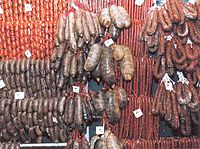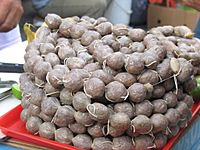Embutido facts for kids
Embutido (say: em-boo-TEE-doh) is a Spanish word for a type of food that is usually a sausage. It comes from the verb "embutir," which means "to stuff." So, embutido is often meat, usually pork, stuffed into a casing. You can find many different kinds of embutido in countries like Spain and Portugal, and in places that used to be their colonies. These sausages are often cured or dried.
In the Philippines, however, because of a mix of Spanish and American cooking styles, embutido means something different. It refers to a type of meatloaf that is often wrapped around slices of egg and sausage.
What is Embutido?
This food is very popular in the cooking styles of the Iberian Peninsula (where Spain and Portugal are) and in countries that were once Spanish or Portuguese colonies. Embutido is a general name for many types of sausages. They are often made by mincing (chopping very finely) meat, especially pork, and then stuffing it into a casing. This casing can be an animal intestine or a man-made one.
Different Kinds of Embutido
There are many different kinds of embutido, each with its own special taste and way of being made. Some popular types include:
- Chorizo or chouriço
- Sobrassada from the Balearic Islands
- Botifarra from Catalonia
- Butifarra Soledeña
- Fuet from Catalonia
- Salchichón
- Blood sausage (also called morcilla or morcela)
- Androlla from Galicia
- Linguiça or longaniza
- Alheira
- Farinheira
- Botillo or botelo, also known as chouriço de ossos
- Paio
- Chosco de Tineo from Asturias
See also
 In Spanish: Embutido para niños
In Spanish: Embutido para niños




